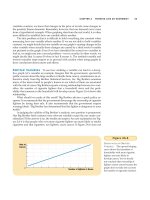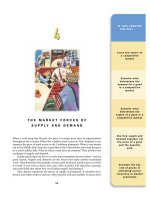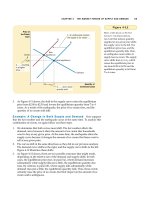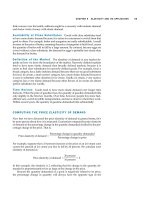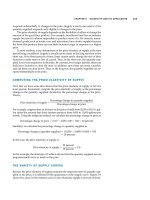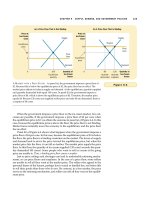Tài liệu Ten Principles of Economics - Part 54 docx
Bạn đang xem bản rút gọn của tài liệu. Xem và tải ngay bản đầy đủ của tài liệu tại đây (296.01 KB, 10 trang )
CHAPTER 24 PRODUCTION AND GROWTH 549
especially important for technological progress. There is no doubt that these issues
are among the most important in economics. The success of one generation’s poli-
cymakers in learning and heeding the fundamental lessons about economic
growth determines what kind of world the next generation will inherit.
higher trade barriers; excessive tax
rates; lower saving rates; and adverse
structural conditions, including an unusu-
ally high incidence of inaccessibility to
the sea (15 of 53 countries are land-
locked). . . .
If the policies are largely to blame,
why, then, were they adopted? The his-
torical origins of Africa’s antimarket ori-
entation are not hard to discern. After
almost a century of colonial depreda-
tions, African nations understandably if
erroneously viewed open trade and for-
eign capital as a threat to national sover-
eignty. As in Sukarno’s Indonesia,
Nehru’s India, and Peron’s Argentina,
“self sufficiency” and “state leader-
ship,” including state ownership of much
of industry, became the guideposts of
the economy. As a result, most of Africa
went into a largely self-imposed eco-
nomic exile. . . .
Adam Smith in 1755 famously
remarked that “little else is requisite to
carry a state to the highest degrees of
opulence from the lowest barbarism, but
peace, easy taxes, and tolerable admin-
istration of justice.” A growth agenda
need not be long and complex. Take his
points in turn.
Peace, of course, is not so easily
guaranteed, but the conditions for peace
on the continent are better than today’s
ghastly headlines would suggest. Sev-
eral of the large-scale conflicts that have
ravaged the continent are over or nearly
so. . . . The ongoing disasters, such as in
Liberia, Rwanda and Somalia, would be
better contained if the West were willing
to provide modest support to African-
based peacekeeping efforts.
“Easy taxes” are well within the
ambit of the IMF and World Bank. But
here, the IMF stands guilty of neglect, if
not malfeasance. African nations need
simple, low taxes, with modest revenue
targets as a share of GDP. Easy taxes
are most essential in international trade,
since successful growth will depend,
more than anything else, on economic
integration with the rest of the world.
Africa’s largely self-imposed exile from
world markets can end quickly by cutting
import tariffs and ending export taxes on
agricultural exports. Corporate tax rates
should be cut from rates of 40 percent
and higher now prevalent in Africa, to
rates between 20 percent and 30 per-
cent, as in the outward-oriented East
Asian economies. . . .
Adam Smith spoke of a “tolerable”
administration of justice, not perfect jus-
tice. Market liberalization is the primary
key to strengthening the rule of law. Free
trade, currency convertibility and auto-
matic incorporation of business vastly
reduce the scope for official corruption
and allow the government to focus on
the real public goods—internal public
order, the judicial system, basic pub-
lic health and education, and monetary
stability. . . .
All of this is possible only if the gov-
ernment itself has held its own spending
to the necessary minimum. The Asian
economies show how to function with
government spending of 20 percent of
GDP or less (China gets by with just 13
percent). Education can usefully absorb
around 5 percent of GDP; health, an-
other 3 percent; public administration,
2 percent; the army and police, 3 per-
cent. Government investment spending
can be held to 5 percent of GDP but only
if the private sector is invited to pro-
vide infrastructure in telecommunica-
tions, port facilities, and power. . . .
This fiscal agenda excludes many
popular areas for government spending.
There is little room for transfers or social
spending beyond education and health
(though on my proposals, these would
get a hefty 8 percent of GDP). Subsidies
to publicly owned companies or market-
ing boards should be scrapped. Food
and housing subsidies for urban workers
cannot be financed. And, notably, inter-
est payments on foreign debt are not
budgeted for. This is because most
bankrupt African states need a fresh
start based on deep debt-reduction,
which should be implemented in con-
junction with far-reaching domestic
reforms.
Source: Economist, June 29, 1996, pp. 19–21.
550 PART NINE THE REAL ECONOMY IN THE LONG RUN
◆ Economic prosperity, as measured by GDP per person,
varies substantially around the world. The average
income in the world’s richest countries is more than ten
times that in the world’s poorest countries. Because
growth rates of real GDP also vary substantially, the
relative positions of countries can change dramatically
over time.
◆ The standard of living in an economy depends on the
economy’s ability to produce goods and services.
Productivity, in turn, depends on the amounts of
physical capital, human capital, natural resources, and
technological knowledge available to workers.
◆ Government policies can influence the economy’s
growth rate in many ways: encouraging saving and
investment, encouraging investment from abroad,
fostering education, maintaining property rights and
political stability, allowing free trade, controlling
population growth, and promoting the research and
development of new technologies.
◆ The accumulation of capital is subject to diminishing
returns: The more capital an economy has, the less
additional output the economy gets from an extra unit
of capital. Because of diminishing returns, higher saving
leads to higher growth for a period of time, but growth
eventually slows down as the economy approaches a
higher level of capital, productivity, and income. Also
because of diminishing returns, the return to capital is
especially high in poor countries. Other things equal,
these countries can grow faster because of the catch-up
effect.
Summary
productivity, p. 533
physical capital, p. 534
human capital, p. 534
natural resources, p. 534
technological knowledge, p. 535
diminishing returns, p. 539
catch-up effect, p. 539
Key Concepts
1. What does the level of a nation’s GDP measure? What
does the growth rate of GDP measure? Would you
rather live in a nation with a high level of GDP and a
low growth rate, or in a nation with a low level and a
high growth rate?
2. List and describe four determinants of productivity.
3. In what way is a college degree a form of capital?
4. Explain how higher saving leads to a higher standard of
living. What might deter a policymaker from trying to
raise the rate of saving?
5. Does a higher rate of saving lead to higher growth
temporarily or indefinitely?
6. Why would removing a trade restriction, such as a tariff,
lead to more rapid economic growth?
7. How does the rate of population growth influence the
level of GDP per person?
8. Describe two ways in which the U.S. government tries
to encourage advances in technological knowledge.
Questions for Review
1. Most countries, including the United States, import
substantial amounts of goods and services from other
countries. Yet the chapter says that a nation can enjoy a
high standard of living only if it can produce a large
quantity of goods and services itself. Can you reconcile
these two facts?
2. List the capital inputs necessary to produce each of the
following:
a. cars
b. high school educations
c. plane travel
d. fruits and vegetables
Problems and Applications
CHAPTER 24 PRODUCTION AND GROWTH 551
3. U.S. income per person today is roughly eight times
what it was a century ago. Many other countries have
also experienced significant growth over that period.
What are some specific ways in which your standard of
living differs from that of your great-grandparents?
4. The chapter discusses how employment has declined
relative to output in the farm sector. Can you think of
another sector of the economy where the same
phenomenon has occurred more recently? Would you
consider the change in employment in this sector to
represent a success or a failure from the standpoint of
society as a whole?
5. Suppose that society decided to reduce consumption
and increase investment.
a. How would this change affect economic growth?
b. What groups in society would benefit from this
change? What groups might be hurt?
6. Societies choose what share of their resources to devote
to consumption and what share to devote to investment.
Some of these decisions involve private spending;
others involve government spending.
a. Describe some forms of private spending that
represent consumption, and some forms that
represent investment.
b. Describe some forms of government spending that
represent consumption, and some forms that
represent investment.
7. What is the opportunity cost of investing in capital? Do
you think a country can “over-invest” in capital? What
is the opportunity cost of investing in human capital?
Do you think a country can “over-invest” in human
capital? Explain.
8. Suppose that an auto company owned entirely by
German citizens opens a new factory in South Carolina.
a. What sort of foreign investment would this
represent?
b. What would be the effect of this investment on U.S.
GDP? Would the effect on U.S. GNP be larger or
smaller?
9. In the 1980s Japanese investors made significant direct
and portfolio investments in the United States. At the
time, many Americans were unhappy that this
investment was occurring.
a. In what way was it better for the United States to
receive this Japanese investment than not to receive
it?
b. In what way would it have been better still for
Americans to have done this investment?
10. In the countries of South Asia in 1992, only 56 young
women were enrolled in secondary school for every 100
young men. Describe several ways in which greater
educational opportunities for young women could lead
to faster economic growth in these countries.
11. International data show a positive correlation between
political stability and economic growth.
a. Through what mechanism could political stability
lead to strong economic growth?
b. Through what mechanism could strong economic
growth lead to political stability?
IN THIS CHAPTER
YOU WILL . . .
Consider how
government budget
deficits affect the
U.S. economy
Develop a model of
the supply and
demand for loanable
funds in financial
markets
Learn about some of
the important
financial
institutions in the
U.S. economy
Consider how the
financial system is
related to key
macroeconomic
variables
Use the loanable-
funds model to
analyze various
government policies
Imagine that you have just graduated from college (with a degree in economics, of
course) and you decide to start your own business—an economic forecasting firm.
Before you make any money selling your forecasts, you have to incur substantial
costs to set up your business. You have to buy computers with which to make your
forecasts, as well as desks, chairs, and filing cabinets to furnish your new office.
Each of these items is a type of capital that your firm will use to produce and sell
its services.
How do you obtain the funds to invest in these capital goods? Perhaps you are
able to pay for them out of your past savings. More likely, however, like most en-
trepreneurs, you do not have enough money of your own to finance the start of
your business. As a result, you have to get the money you need from other sources.
SAVING, INVESTMENT, AND
THE FINANCIAL SYSTEM
553
